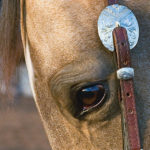Most horse owners in the United States have the luxury of living in an area where Pigeon Fever doesn’t occur.? Many of us have heard about it, but relatively few actually have horses that have contracted it.? However, we?ve closely followed state reports that indicate that the disease is popping up in more places where it was previously only discussed.
Drought conditions throughout the United States are thought to be the culprit for bringing this nasty problem into the Midwest and South, even as far as Arkansas, Louisiana and Florida, places where flies are nearly constantly around. We decided it was important that our readers become familiar with the basics of Pigeon Fever, early detection and prevention tips.
WHAT IS PIGEON FEVER’ Pigeon Fever, rather ironically, doesn’t involve pigeons at all, and only occasionally involves a fever.? It earned its name because many horses that contract it have their chest swell up to resemble a ?pigeon breast.?? Also called ?dryland distemper? (enter the drought conditions), this disease results from infection with bacteria called Corynebacterium pseudotuberculosis.
IS IT CONTAGIOUS’ The good news is that humans can’t contract this infection from horses.? The bad news is that it is highly transmissible from horse to horse.
Pigeon Fever is spread primarily through fomite transmission.? Fomites are things like flies, human hands, grooming equipment and tack, any object that can carry an infectious pathogen from one animal to another.? Among the fomites, flies are the most common culprit thought to spread Pigeon Fever.
The organism prefers to live and multiply in dry soil or manure.? Flies can pick it up on their mouth-piece and then move to the horse where they can bite and inoculate it into the skin.? If an infection takes off, the horse will begin to shed the bacteria from its body (nasal secretions, feces and pus from abscesses).
Pus from abscesses is the most potent source of bacteria, and flies that come into contact with the pus present a significant risk to non-infected horses.
The most common fly species to carry and spread Pigeon Fever is the horn fly (Haematobia irritans).? You might recognize them from observing cattle. They are the tiny, black flies that swarm all over cattle.? They bite and feed on blood, and in some circumstances, carry the Pigeon Fever bacteria on their mouthpiece.
Often these fearless little pests sit in blankets on cow?s backs and will quickly resettle right back in the same spot when the animal attempts to swat them away.
In horses, they commonly hang out not only near the withers, but also on the ventral midline under the belly.? Does your horse have flaky, itchy skin on his ventral midline’? Horn flies are likely to blame.
WHAT SHOULD I LOOK FOR’ Pigeon Fever can manifest itself in one of three ways.? The first, and most common, is an external infection that results in the formation of one or more abscesses.? An abscess is a pus pocket created when the body attempts to wall off and encapsulate a foreign invader (such as bacteria).? The bacteria grow and divide inside the abscess until so much pressure builds up, it bursts.? Just think of a Pigeon Fever abscess as a gigantic zit on the horse.
In the early stages of this form of Pigeon Fever, most horses will be lethargic and have a slight fever (usually between 101° and 102° F).? The fever usually goes away after a few days, but then owners notice a swelling in their horse’s chest.
Some owners mistake this swelling for a kick wound, but it progresses rapidly and within days, becomes hard.? Some owners will notice edema between the legs, or in some cases, a swollen sheath since this infection can manifest anywhere along the ventrum of the horse.? In rare cases, the infection will take off in the fold of the tail or even on the back.
The abscess grows and matures rapidly and within days to weeks, will burst (or be cut open by the veterinarian). Horses will commonly be lame during the maturation phase of the abscesses, since the pressure that builds up can be painful.? After the abscess bursts and drains, it will then heal over a period of weeks.
In the second form of the disease, which is far less common than the first, the horse can develop an internal infection (usually in the form of an internal abcess). Internal abscesses commonly occur in the liver and spleen, but they have also been reported in the lungs, uterus and on the kidney.? In this form of the disease, the horse will display generalized lethargy, recurrent fever, loss of apetite, and weight loss.? Veterinarians diagnose it by blood testing and also by ultrasounding the abdomen.
In the third, and most rare form of the infection, horses can get a condition in the leg called ulcerative lymphangitis.
One leg will become extremely swollen and edematous, sometimes two to three times its regular size.? The swelling can extend all the way up to the stifle.? The edematous leg will usually begin to leak serum directly through the skin or out of multiple ulcerative wounds that extend up and down the leg.? Horses may or may not have a fever with this form of the infection.? Surprisingly, they are not always lame with this ailment.
NOT AN EVERDAY ABSCESS. If you have a horse that has a swelling that is growing rapidly and becoming hard, you should be suspicious of an abscess.
However, not all abscesses are Pigeon Fever.? The only way to know for sure is to have your veterinarian do blood testing and/or get a sample of the pus inside the abscess and turn it into the lab for culturing.? it’s important, for the biosecurity of the property your horse is on and the safety and health of surrounding horses, that you identify the bacteria in an abscess.
WHEN IS IT MOST PREVALENT’ Because the bacteria that causes Pigeon Fever prefers a dry, warm environment and climate, the disease occurs primarily in mid-summer to early fall.? In some cases, Pigeon Fever can last up to a year in a horse, with wave after wave of abscess.
A HORSE IN OUR BARN HAD PIGEON FEVER BUT NOT MINE.We don’t fully understand why Pigeon Fever seems to be problematic for only some horses.? Inherent factors, such as the horse’s immune competence, may play a role.
For instance, if a horse was exposed to Pigeon Fever previously in its life and developed antibodies to the bacteria through exposure, that horse will be less likely to come down with an infection because he may have some degree of immunity to the bug. In addition, the horse’s nutritional intake?trace mineral and vitamin levels (such as selenium, copper, zinc, and others)?will influence the strength of the horse’s immune system.
Finally, if a horse is stressed (from training, showing, travel), or if the body is affected by a chronic disease that can impair immune function (Cushing?s disease), the he may be more likely to get the disease.
HOW IS IT TREATED’ Surprisingly, only some cases of Pigeon Fever are treated with antibiotics.? It seems counter intuitive since this is a bacterial infection.? However, in most cases of external abscesses, the infection will be self-limiting. This means that the infection will run its course and resolve on its own without a need for antibiotics.
In the early stages of the abscess maturation, giving anti-inflammatory medications, such as bute, can help not only because they help control fever, but also because they mitigate pain caused by the pressure that builds in the abscess.
Many owners try to accelerate the maturation of an abscess and bring it to a head by applying warm compresses to it several times per day.? The warmth from the compress more or less incubates the bacteria, thus accelerating their maturation in order to get the abscess to burst.
In the rare cases, involving internal abscesses or ulcerative lymphangitis, treatment with multiple types of antibiotics will be necessary, as will long-term use of anti-inflammatory drugs.
Owners that have horses with either of these two conditions should be prepared for long-term, expensive treatments that will often require medications to be given two to three times per day.? Also, prognosis for survival with these two forms of the disease is much lower than the most common form described above.
In all cases, horses being treated should have shelter, fly control, bedding to lie down in, feed that is hung at chest level (to make it so that the horse doesn’t have to stretch down and compress a chest abscess to get to it), and clean water.? Protection from the weather will help horses that are sick, especially ones with fevers.
BOTTOM LINE. Prevention is key. No barn wants to be labeled as a ?Pigeon Fever barn.?? Since this disease can exist for months in the soil, biosecurity measures are crucial to avoid its spread through a barn and to avoid it reinfecting horses year after year. ?See chart about preventing pigeon fever.
Horses that become infected with Pigeon Fever usually have immunity to re-infection for a period of five to seven years. In addition, foals less than six months old don’t commonly get the disease (suggesting that maternal immunity from the antibodies in their mother?s colostrum is protecting them).? Both of these findings suggest that horses with an antibody reserve (or titer) will be less likely to become infected with Pigeon Fever.
Currently, vaccine companies apparently don’t see the economic logic in producing a Pigeon Fever vaccine. That’s because, traditionally, Pigeon Fever was thought to be a limited problem, mainly in California and sporadic. Now, as it appears to be spreading, perhaps a vaccine will be forthcoming.
Until then, your best prevention is to be aware of the symptoms. If you suspect Pigeon Fever, ask your veterinarian to do a culture to identify the bacteria. If it is positive for Pigeon Fever, work with your veterinarian for treatment and immediately implement our tips for stopping its spread.
Article by Contributing Veterinary Editor Dr. Grant Miller.










